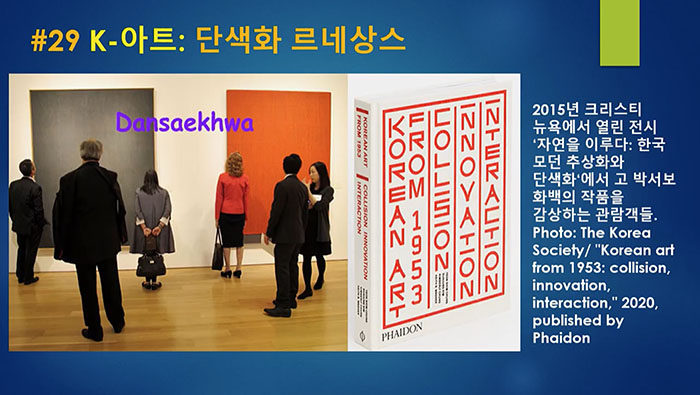아시아 소사이어티 한국미술 토론회 'Transcending Borders: Sohl Lee and Jung Joon Lee in Conversation'(10/7)
뉴욕 아시아 소사이어티(회장 강경화)가 10월 7일 오후 6시 30분 한국미술 토론회 'Transcending Borders: Sohl Lee and Jung Joon Lee in Conversation'를 연다. SUNY 스토니브룩대 이정준(Jung Joon Lee) 교수는 'Shooting for Change; Korean Photography after the War(듀크대, 2024)'의 저자이며, 로드아일랜드 디자인스쿨(RISD) 이솔(Sohl Lee) 교수는 출간 예정인 'The Minjung Art Movement and the Politics of Decolonization in South Korea'의 저자다. 토론의 진행은 야스후미 나카모리(Yasufumi Nakamori) 뮤지엄 디렉터가 맡는다.
Asia Society New York
Transcending Borders: Sohl Lee and Jung Joon Lee in Conversation
Monday 7 Oct 2024
6:30 - 8 p.m.

Sohl Lee(left)/ Jung Joon Lee
In this conversation moderated by Asia Society Museum Director Yasufumi Nakamori, art historians and scholars Dr. Jung Joon Lee and Dr. Sohl Lee will share their insights on postwar artistic responses in South Korea. Dr. Jung Joon Lee’s current research and latest publication, Shooting for Change; Korean Photography after the War (Duke University Press: 2024), examine the role photography has played in both creative and documentary endeavors during historical events. Dr. Sohl Lee brings her perspective from a forthcoming title that focuses on Minjung art of the 1970s and 1980s, a movement where artists responded in wide-ranging mediums to the political and social issues of the time. The stories told through the art of this period that has emerged from Dr. Jung Joon Lee and Dr. Sohl Lee’s new research provide a fuller picture of postwar life in South Korea and the power of art in times of uncertainty.
Speakers
Sohl Lee is an Associate Professor of Art History in the Department of Art at Stony Brook University (SUNY). She holds a BA with honors in Art History and International Relations from Smith College and a PhD in Visual and Cultural Studies from the University of Rochester. Her first book, Reimagining Democracy: The Minjung Art Movement and the Politics of Decolonization in South Korea (forthcoming from Duke University Press), examines the multifaceted process by which a particular decolonial aesthetics of politics emerged during South Korea’s democratization. Her research interests also include Buddhist modernism, ecocriticism, pedagogical curating, and Global Asias. She has received fellowships and grants from the Social Science Research Council, the Getty Research Institute, the Korea Foundation, and the Arts Council Korea, among others. Her publications have appeared in exhibition catalogues, magazines, and academic journals in both South Korea and the US.
Jung Joon Lee is an associate professor of art history at Rhode Island School of Design. Lee’s research explores the intersections of art and politics, transoceanic intimacies, decoloniality, and gender and sexuality. Lee’s new book, Shooting for Change: Korean Photography after the War (Duke University Press, 2024) treats Korea’s transnational militarism as a lens through which to examine how photography makes meaning and shapes history. Lee was a 2022-23 Society for the Humanities Fellow at Cornell University and visiting scholar at Yonsei University’s Graduate School of Communication and Arts in 2022. Lee is currently working on a monograph project exploring photography and art exhibitions as spaces of transoceanic collaboration, kinship making, and repair. Lee received her Ph.D. in art history from CUNY Graduate Center.
https://asiasociety.org/new-york/events/transcending-borders-sohl-lee-and-jung-joon-lee-conversation

한류를 이해하는 33가지 코드
#29 K-Art 단색화 부활하다 The Revival of the Korean Monochrome Painting
2010년대 세계 미술계는 한국의 모노크롬 추상화 '단색화(Dansaekhwa)'를 재발견했다. 1970년대 독재 지하에서 시작한 박서보, 윤형근, 정상화, 정창섭, 하종현 화백 등 단색화가들은 작고했거나, 이제 황혼의 나이에 전성기를 맞고 있다. 메트로폴리탄뮤지엄, 구겐하임뮤지엄, 필라델피아뮤지엄 등 미국의 주요 미술관에서 한국 미술 특별전이 이어지고 있으며, 서울은 이제 세계 미술의 메카로 발돋움했다.
https://www.nyculturebeat.com/index.php?mid=Focus&document_srl=4089137
33 Keys ro Decoding the Korean Wave
#29 K-Art: The Revival of the Korean Monochrome Painting
In the 2010s, the global art community experienced a renaissance in Korean monochrome abstraction known as 'Dansaekhwa.' Monochromatic painters, who emerged during Korea's era of dictatorship in the 1970s, now find themselves in their prime during the twilight of their careers. I explored the history of Dansaekhwa and the masters such as the late Yun Hyong-keun, late Chung Chang-sup, late Park Seo-Bo and Chung Sang-Hwa, Ha Chong Hyun. Special exhibitions of Korean art are continuing at major art museums in the United States such as the Metropolitan Museum, the Guggenheim Museum, and the Philadelphia Museum. Furthermore, Seoul has now emerged as a global art mecca.
https://www.nyculturebeat.com/index.php?mid=Zoom&document_srl=4124933




 MoMA 배우 사무엘 L. 잭슨 회고전(Samuel L. Jackson: A Tribute,...
MoMA 배우 사무엘 L. 잭슨 회고전(Samuel L. Jackson: A Tribute,...
 2024 뉴욕 발트해영화제(New York Baltic Film Festival, 11/6-17...
2024 뉴욕 발트해영화제(New York Baltic Film Festival, 11/6-17...

